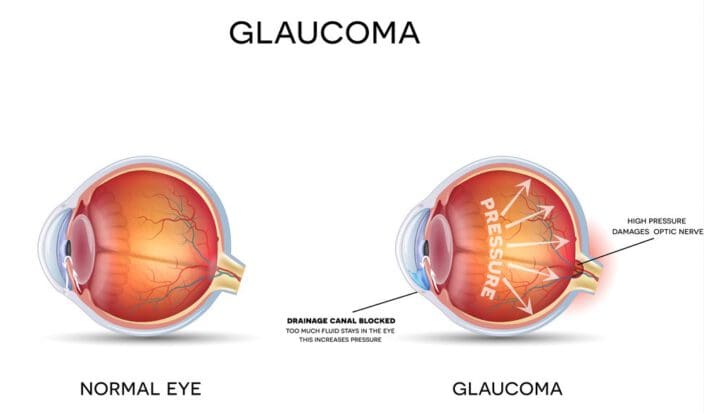What Is iStent for Glaucoma?
Home / Diagnosed With Glaucoma /
Last Updated:
Glaucoma effects approximately 3 million people in the United States. It is not curable, and it can lead to blindness, especially if it is left untreated.
Glaucoma is characterized by increases in intraocular pressure (eye pressure). There are various treatment options, but many of the current treatments are not ideal for everyone.
Table of Contents
While an effective treatment, using eye drops every day can be difficult for some people. A newer treatment option is referred to as iStent. This innovative treatment can help to relieve intraocular pressure.
The iStent treatment option isn’t right for everyone. You must first determine if you are a candidate. Your doctor can help in evaluating your eligibility.
If you are a good candidate, take the time to read the research on this treatment option. It is imperative to understand what iStent is and what it can do before agreeing to the treatment.

Learning About Glaucoma
When someone has glaucoma, they can experience optic nerve damage due to the pressure in their eye being abnormally high. People of all ages can develop glaucoma, but it usually occurs in older adults.
In many cases, people do not have symptoms during the early stages. Glaucoma may get to an advanced stage before any symptoms are apparent. Once vision loss occurs due to glaucoma, it cannot be recovered.
You deserve clear vision. We can help.
With 135+ locations and over 2.5 million procedures performed, our board-certified eye surgeons deliver results you can trust. Your journey to better vision starts here.
When someone has open-angle glaucoma, they may experience:
- Irregular blind spots in their central or peripheral vision.
- Tunnel vision in the advanced stages of glaucoma.
Acute angle-closure glaucoma may cause:
- Eye pain.
- Blurry vision.
- Eye redness.
- Severe headache.
- Stomach upset and vomiting.
- Halos around lights.

Optic nerve damage is what causes glaucoma. As the nerve deteriorates gradually, the visual field starts to develop blind spots. An eye pressure increase is what contributes to the damage to the optic nerve.
The increase in eye pressure is due to eye fluid accumulating. This can be due to too much of the fluid being produced or because the fluid is not draining properly.
The trabecular network, a type of tissue, is where the internal fluids normally drains. This tissue is located where the cornea and iris meet.
The following are risk factors for glaucoma:
- Being over 60 years old
- A family history of this eye disease
- A cornea that is thin at the center
- A history of eye surgery
- A history of eye injury
- High internal eye pressure
- Being Asian, Hispanic, or African American
- Certain medical conditions like heart disease, sickle cell anemia, diabetes, and high blood pressure
- Extreme farsightedness or nearsightedness
- Long-term use of corticosteroid drug, especially in eye drop form
What Is iStent?

The U.S. Food and Drug Administration approved iStent for glaucoma in 2012. This stent can be used in combination with cataract surgery to decrease intraocular pressure in people who have both a cataract and mild to moderate open-angle glaucoma.
iStent is a type of tiny titanium tube. Its length is 1 millimeter.
A doctor places iStent into the eye via a surgical procedure. To properly place the device, the doctor makes an incision into the cornea. The stent is then carefully put into the eye via the filtering tissue meshwork of the eye.
Once the device is in place, it allows for an opening between the Schlemm’s canal and anterior chamber of the eye. This lets the eye fluid bypass the drainage system that is damaged, so the eye fluid goes into the deeper tissues of the eye. This allows for a reduction in intraocular pressure.
This stent works just like the ones that doctors insert into blood vessels. It makes it possible for the fluid to take an alternate route so it is not able to accumulate.
Who Is a Candidate for iStent?
Since glaucoma is a leading cause of blindness, it is important to find a treatment option that people can comply with. Lack of compliance could result in worsening of the condition and an increased risk of blindness.
This implant may be ideal for people who are currently receiving glaucoma treatment as well as those newly diagnosed with the condition.
The implant is very tiny. Once it is in place, people generally do not notice it. It is meant for use in people who need to have cataract surgery but who also have issues with intraocular pressure.
One study in the U.S. concluded that 68 percent of people with glaucoma who received this implant were able to control their glaucoma without medication 12 months after implantation.
You deserve clear vision. We can help.
With 135+ locations and over 2.5 million procedures performed, our board-certified eye surgeons deliver results you can trust. Your journey to better vision starts here.
Results of iStent

One study was performed in Italy. The researchers were evaluating the differences between cataract surgery using iStent and traditional cataract surgery.
With cataract surgery only, the baseline intraocular pressure was 17.3. After surgery, the intraocular pressure was 15.7.
With combination cataract surgery and iStent, the baseline intraocular pressure was 17.9. After surgery, the intraocular pressure was 14.8.
Of the people in the group that only received cataract surgery, 24 percent were able to stop their glaucoma eye drop medication. Of the people in the group that received iStent and cataract surgery, 67 percent were able to stop their medication.
This surgery typically results in very little damage or manipulation of normal eye tissue. Compared to traditional surgical options for glaucoma, the implantation of this device is generally faster to perform and allows for faster recovery. For many people, it might be a safer option.
The goal with implanting this stent is to reduce intraocular pressure so the person no longer needs to use their glaucoma eye drops. It might also reduce the person’s need to have a potentially riskier surgery for glaucoma at some point in the future.
Potential Risks
For the most part, the risks are minimal with implantation of iStent. The risks are similar to those that can occur with cataract surgery, such as infection, retinal detachment, inflammation, and retinal tears.
After the device is put into place, it is not abnormal for people to experience some bleeding at the site. In most cases, this is a temporary issue that is brief. Should the bleeding become problematic, there are topical eye medications that can usually manage it.
It is possible for the stent to get obstructed by eye tissue. While rare, it is possible for this device to dislocate itself.
Talk to Your Doctor
If someone wants to avoid daily eye drops or medications, they can talk to their doctor about iStent for glaucoma. Together, they can discuss the pros and cons to determine if this treatment option is ideal.
You deserve clear vision. We can help.
With 135+ locations and over 2.5 million procedures performed, our board-certified eye surgeons deliver results you can trust. Your journey to better vision starts here.
References
- Glaucoma: Facts and Figures. Bright Focus Foundation.
- Leading Causes of Blindness. MedlinePlus.
- iStent Glaucoma Technology. Cleveland Eye Clinic.
- Glaucoma. Mayo Clinic.
- The FDA Approves a New Stent Device for Glaucoma Surgery with Cataracts. Vision Aware.
- Phacoemulsification Versus Phacoemulsification with Micro-Bypass Stent Implantation in Primary Open-Angle Glaucoma: Randomized Double-Masked Clinical Trial. Journal of Cataract and Refractive Surgery.
This content is for informational purposes only. It may have been reviewed by a licensed physician, but is not intended to serve as a substitute for professional medical advice. Always consult your healthcare provider with any health concerns. For more, read our Privacy Policy and Editorial Policy.